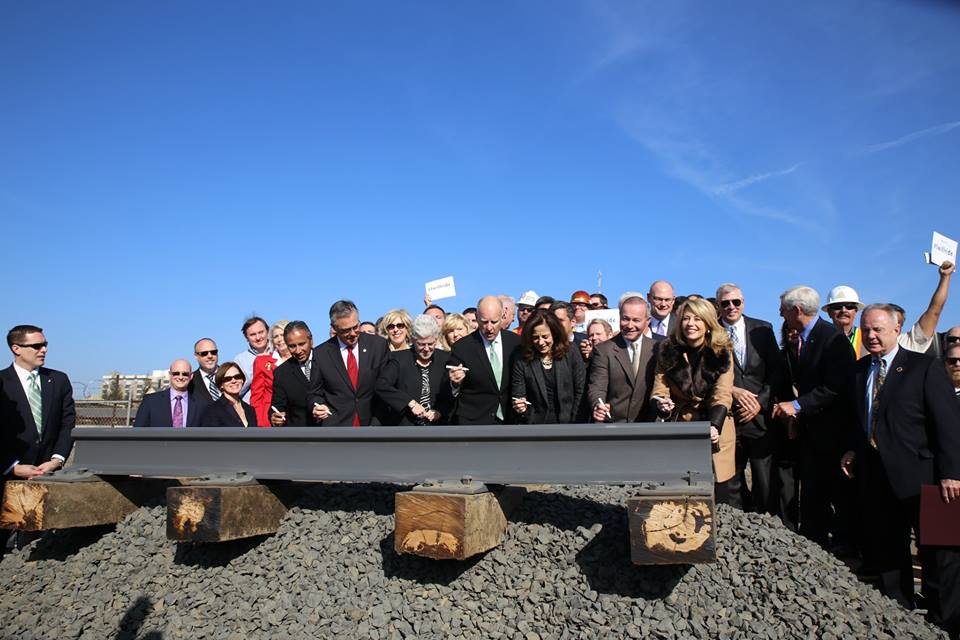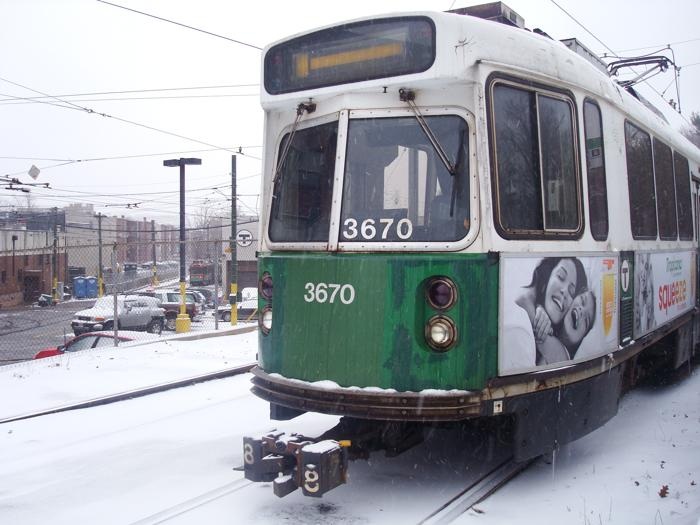Happening Now
Hotline #893
January 9, 2015
Six years after California’s voters passed a bond measure funding a statewide high-speed rail system, state, federal and local officials gathered in Fresno on January 5 to mark the beginning of construction on the train that will run 220 mph between San Francisco and Los Angeles.
The completed system will stretch 800 miles along 24 stations. Monday’s event inaugurated construction on the initial operating segment, a 130-mile corridor that runs from Madera to north of Bakersfield in the state’s Central Valley.
“We are leaders in renewable energy and efficiency; we have extended health care to millions; we are transforming our educational and criminal justice systems; we are building the nation’s only high-speed rail system,” said Governor Brown in his state of the state address (delivered last week). “…California will build for the future, not steal from it. And as we do, we will know in our hearts patriotism is not just defending the country of our fathers, but preparing the land for our children.”
Despite the self-evident enthusiasm of the roughly 1,200 people in attendance, the event was not without its detractors. Several Republican members of California’s Congressional delegation have attacked the project since its inception, and they used this most recent milestone to question the project’s viability.
“Congress will eventually see high-speed rail in the U.S., but it just won’t be in California first,” said Representative Jeff Denham, Chair of the House Transportation and Infrastructure’s Subcommittee on Rail. “There’s a right way to do it. But there’s not only a funding gap in California, the funding is non-existent, and we are going to make sure that there is no more federal money at all going forward.”
Governor Brown explicitly addressed these naysayers during the event, pointing to the robust, dedicated source of funding secured through the state’s recently-passed carbon tax. The project will receive $250 million for construction costs in the first year, along with 25% of future cap-and-trade revenue.
“When I first was elected governor, I had some doubts about this project. ... But my wife Anne—who used to be a Republican—when she said, no, you gotta take this money and you gotta build, the fact that she was a Republican gave me a lot of confidence…”
The project did, however, receive a big endorsement from Senator Harry Reid (D-NV). The Senate Minority Leader hopes to see the Xpress West project—which would establish a high-speed train between Las Vegas and Los Angeles—receive a boost in the arm.
“Today’s groundbreaking in California is exciting news for the future of high-speed rail in the United States, and especially in the West,” said Reid. “Anyone who has traveled Interstate 15 on a Friday or Sunday afternoon, or really at any time on any day, knows the bumper-to-bumper gridlock it entails. High-speed rail between California and Nevada will help reduce this congestion and allow passengers to travel swiftly and easily between the two states. We want travelers visiting the great restaurants, hotels and attractions in Las Vegas, not idling in their cars for hours. High speed rail will also create thousands of good-paying jobs in Nevada at a time when our economy is improving, but not where it should be.”
A deep freeze across much of the Midwest and East Coast has led to difficult transportation conditions for millions of America’s passengers.
Highways and roads struggled to deal with a relatively light snowfall on Tuesday. And while transit and commuter rail systems are normally more resilient than roads in the face of extreme winter weather, rail systems in major metropolitan areas across the country struggled with the frigid temperatures:
- In Chicago, 172 passengers were stranded overnight when Amtrak’s Lake Shore Limited (Chicago – New York City – Boston) was delayed by the extreme weather. Cold-induced mechanical problems, then concerns over federal Hours of Service regulations, led to the train being delayed for almost 14 hours. [Chicago Tribune]
- Operations on New Jersey Transit trains were affected when the cold caused mechanical issues with the overhead wires that power the trains. [Associated Press]
- The Massachusetts Bay Transportation Authority’s trains have been affected, with concerns over cracked rails and air brake systems leading to slower operating speeds. [Boston.com]
- The Washington Metropolitan Area Transportation Authority—which serves D.C., Maryland, and Virginia—saw five of its six metro rail lines suffer significant delays. [Washington Post]. Virginia Railway Express—which also serves Virginia and D.C.—experienced problems as well.
Friends of the Cardinal (FOC) issued a call to officials in Indiana to ensure the continuation of the Hoosier State service. Indiana is facing a January 31 deadline to secure a new operator for the Indianapolis - Chicago service. The train is currently run by Amtrak, but the Indiana Department of Transportation has been investigating private sector operators.
FOC, a West Virginia passenger rail advocacy group, has a vested interest in the continuation of Indiana’s state service; the Cardinal, Amtrak’s long-distant train that connects Chicago with New York City (via Indianapolis, Cincinnati, Charlottesville, VA, and Washington, D.C.), operates over the same 196-mile stretch of tracks as the Hoosier State. The Cardinal only runs three days per week, with the Hoosier State offering a truncated version of the service the other four days.
In its resolution adopted this month, FOC acknowledges the long and difficult negotiations that bookended the federal handover of the operating costs of the Hoosier State to Indiana, commending the endurance of local passenger rail advocates:
Citizens of Indiana and IPRA [Indiana Passenger Rail Alliance] are praised by the West Virginia group for “fostering a continued growth in ridership, continued expressions of official support for The Hoosier State, through participation in meetings, Town Halls, through making resolutions and many other appropriate forms of citizen participation in democratic decision-making.”
IPRA announced in its monthly publication released Thursday that “INDOT’s discussions are ongoing to obtain pricing from Amtrak.” Quoting INDOT spokesman Will Wingfield, “INDOT’s negotiations with Iowa Pacific (a private concern) have advanced to the point where the discussions with Amtrak are now on a critical path.
“Should contract negotiations with Amtrak not conclude before Jan. 31, then INDOT would discuss a short extension of the existing service,” IPRA reports in All Aboard Indiana, the organzation’s monthly publication distributed throughout Indiana.
You can find out more in this month’s edition of IPRA’s newsletter.
Following the completion of construction work by Burlington Northern Santa Fe Railroad, the Empire Builder will soon be able to return to its normal schedule.
In order to accommodate additional traffic from increased oil drilling in the region, BNSF committed to an aggressive $1 billion capacity expansion program. The resultant change to service inconvenienced many communities along the line—particularly in North Dakota, where busing was periodically in effect for Grand Forks, Devils Lake, and Rugby.
Locals along the route are relieved, as they depend on the train to connect to markets and services in big cities, with passenger traffic flowing both in and out.
"We've had some real issues since the schedule changed," Dylan Boyle, director of the Whitefish Convention and Visitor Bureau in Montana, told Mass Transit Magazine. "The visitor experience is not what we wanted it to be. Hotels, especially, were having a hard time with the schedule. The new times are much more welcoming."
Boyle estimates that around 15,000 visitors were lost over the previous ten months as a result of the degradation to service. He’s optimistic, however, that a return to normalcy will go a long way to restoring the local economy. Amtrak, meanwhile, is doing its part to be good neighbor by offering 30% discounts on tickets to Whitefish for travel between now and April 20.
Atlanta’s downtown streetcar system’s inaugural run went off without a hitch on December 30, 2014, bringing droves of crowds eager to see the new line in action.
The streetcar will run in a 2.7 mile loop through downtown Atlanta, connecting 12 stops between Centennial Olympic Park and the Martin Luther King Jr. National Historic Site. It marks the return of streetcar service after a 66-year absence.
"These projects are for the future, and when you look around, the cities who we're competing with around this nation and around the world, they've made investments in public transportation," MARTA Chief Executive Officer Keith Parker told The New York Times.
The U.S. Department of Transportation announced almost $1 billion in federal funds on January 5 to extend the Massachusetts Bay Transportation Authority’s (MBTA) Green Line light rail line from East Cambridge to Somerville and Medford.
The project will add a 4.7-mile extension to the current Green Line terminal, Lechmere Station. The extension will branch out to Union Square in Somerville and College Avenue in Medford.
“The Green Line extension will improve transit options for residents of Somerville and Medford by eliminating the need for bus to rail transfers and providing a one-seat transit ride to thousands of jobs in downtown Boston and along the Green Line,” said Acting Federal Transit Administrator McMillan. “This project will make a huge difference for thousands of residents along the corridor who need and deserve reliable access to jobs and educational opportunities throughout the Boston metropolitan area.”
News In Brief
—Metropolitan Transit Authority of Harris County (METRO) announced this week that six new light-rail cars entered service on the city’s rail system beginning January 7.
The cars were produced by American workers at the CAF USA plant in Elmira, New York. CAF USA is a subsidiary of Spanish rail manufacturing giant Construcciones y Auxiliar de Ferrocarriles, which expanded into the U.S. to compete in the rapidly growing U.S. streetcar market.
Passenger Advisory
—Amtrak is offering a special 20% on winter train travel in Illinois, Michigan and Missouri. Discounts are available on the Lincoln Service, Illinois Zephyr/Carl Sandburg, Illini/Saluki, Wolverine Service, Blue Water, Pere Marquette, and the Missouri River Runners. Find out more at Amtrak.com.
—Amtrak is offering a special promotion where Amtrak Guest Rewards members can earn a free roundtrip on Northeast Corridor services. AGR members can earn one free Acela Express roundtrip for every three qualifying Acela roundtrips (or six one-ways), and one free round trip for every three qualifying Northeast Regional roundtrips (or six one-ways) taken between now and February 28. Check out Amtrak.com for more details.
--Beginning January 26, Sunset Limited Trains No. 2 and No. 422 (with Texas Eagle through cars) will depart Los Angeles two hours earlier than usual at 8:00 PM to accommodate Union Pacific Railroad track rehabilitation work. The trains will operate two hours earlier at all stops through El Paso, when a two hour layover will allow the train to return to its regular schedule. The temporary schedule will be in place through March 22.
"I’m so proud that we came together in bipartisan fashion in the Senate to keep the Southwest Chief chugging along, and I’m grateful for this recognition from the Rail Passengers Association. This victory is a testament to what we can accomplish when we reach across the aisle and work together to advance our common interests."
Senator Tom Udall (D-NM)
April 2, 2019, on receiving the Association's Golden Spike Award for his work to protect the Southwest Chief


Comments